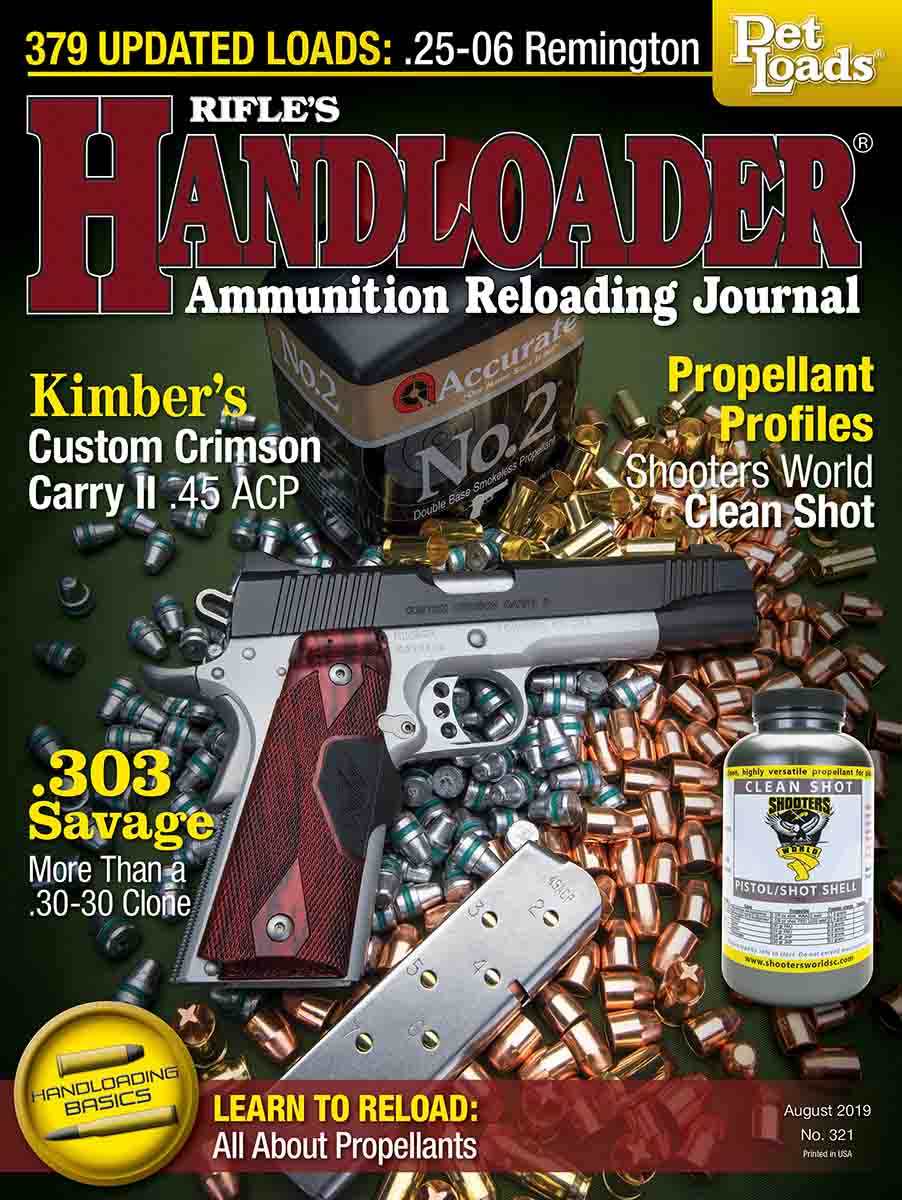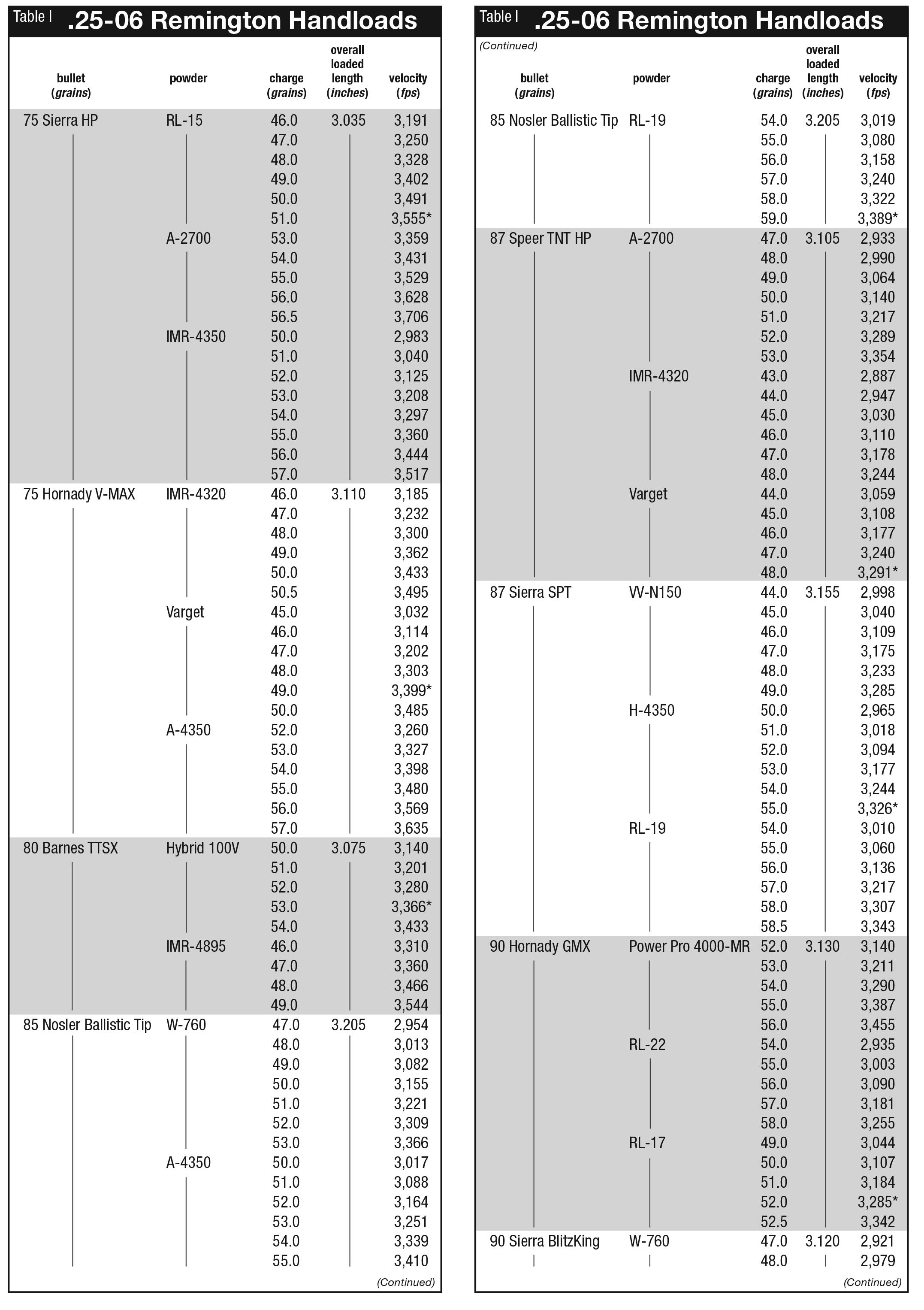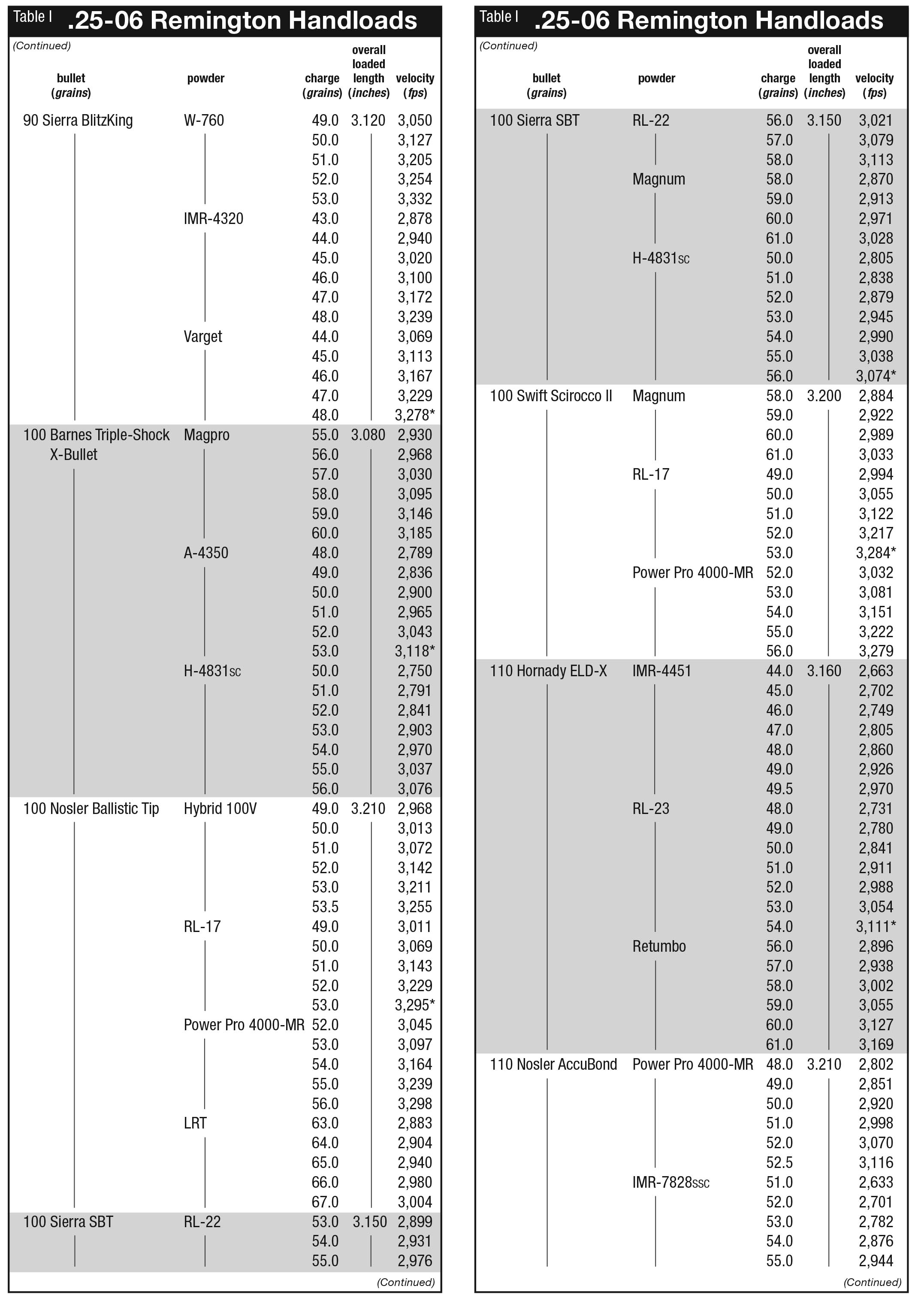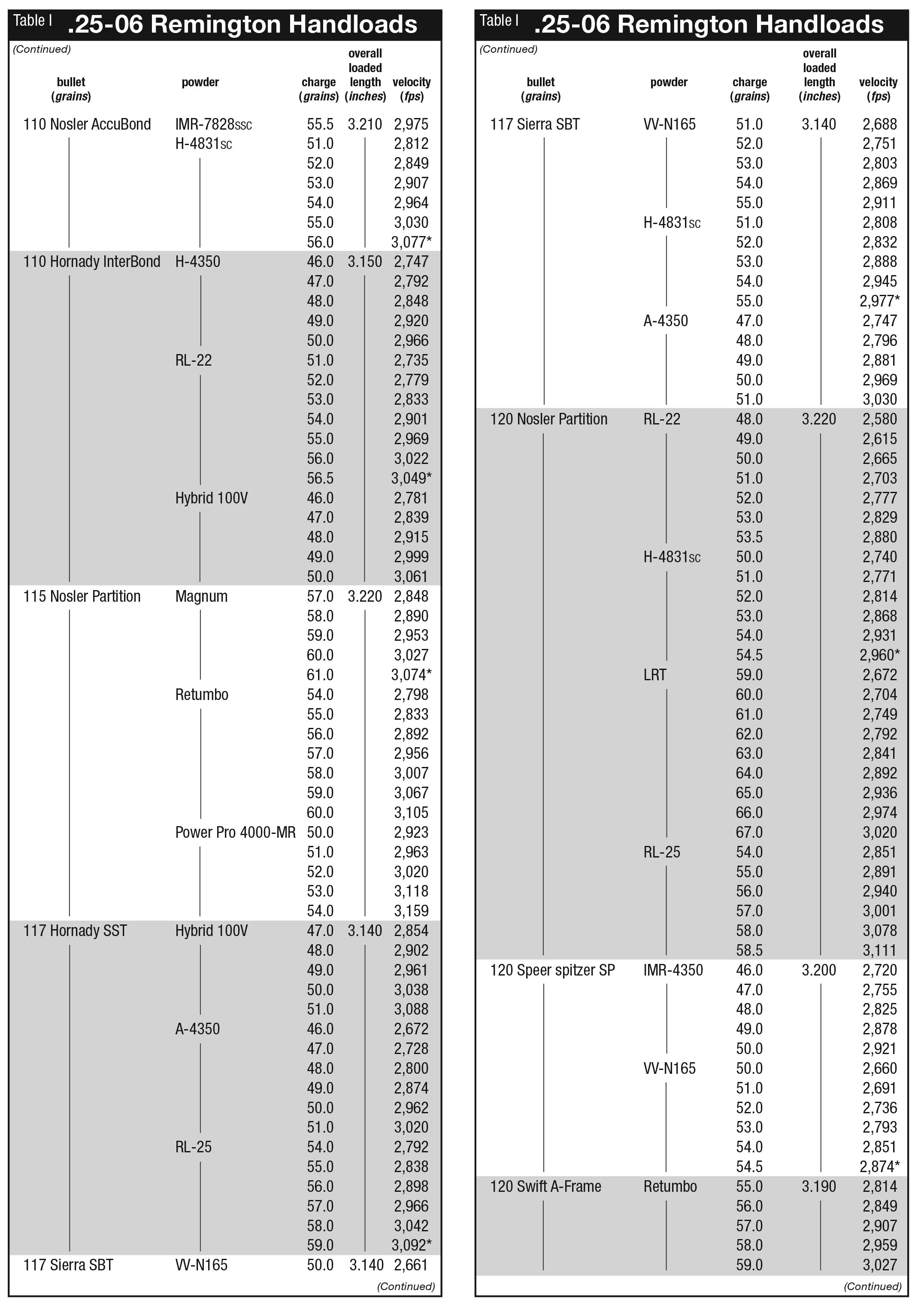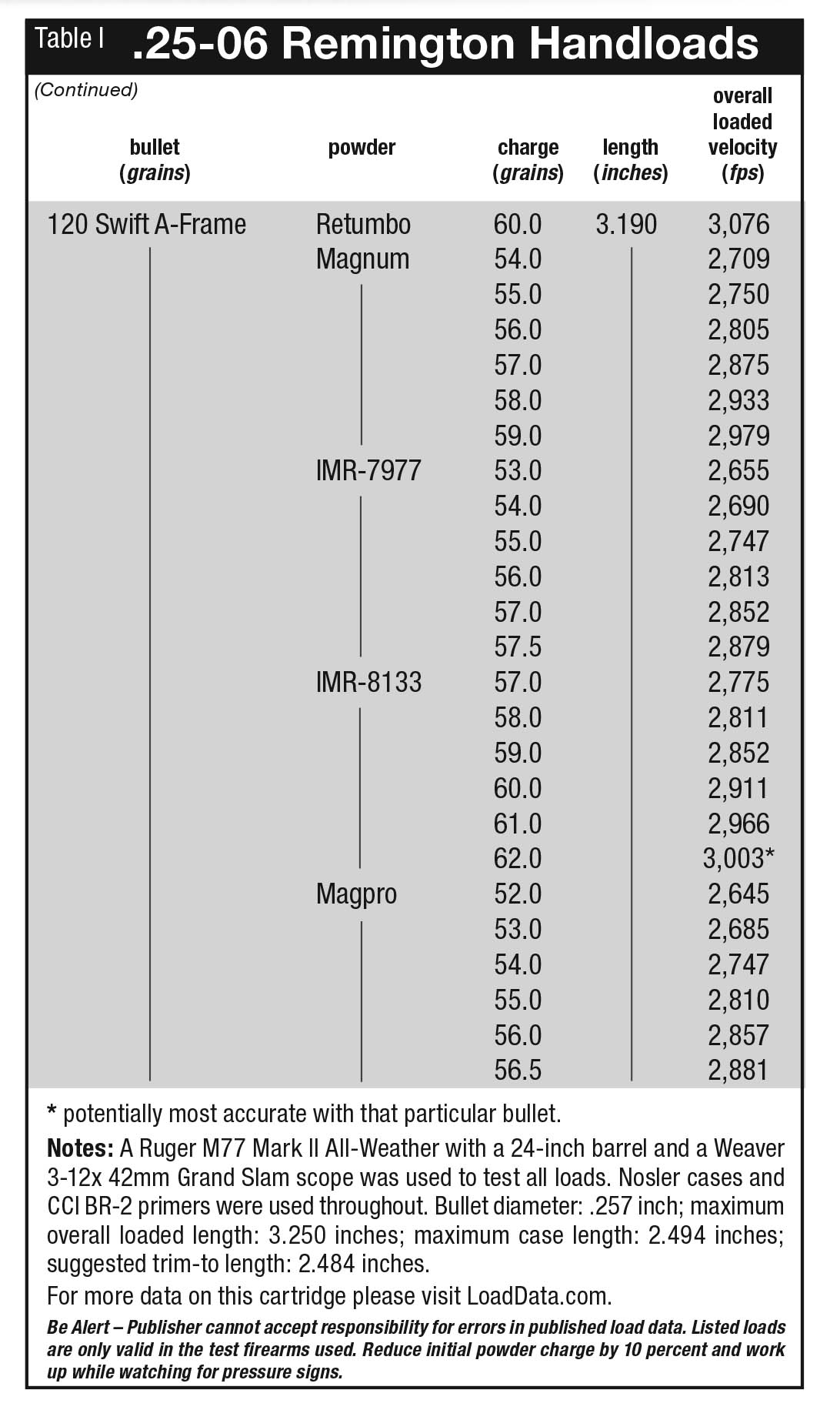.25-06 Remington (Pet Loads)
Updated Loads for a 50-Year-Old Favorite
feature By: Brian Pearce | August, 19



However, the cartridge was far from dead. For example, around 1920 gunsmith A.O. Niedner built custom rifles chambered for the above Newton cartridge. However, his wildcat was named the .25 Niedner. Since he offered rifles, Niedner is often mistakenly credited for designing what would become the .25-06 Remington. Other variations of the same cartridge were soon developed by individuals and firms, including the .25 Hi Power, G&H .25 High Power Special, .25 Whelen High Power Special and the .25-100-3000 (a name that indicated the cartridge’s ability to push a 100-grain bullet to 3,000 fps). These wildcats were all based on the same .30-06 case necked down but had small dimensional differences and may not be interchangeable with the modern SAAMI standardized .25-06 Remington.
Although the above wildcats became popular, it wasn’t until the availability of IMR-4350 powder in 1940 and surplus military 4831 powder (used in 20mm cannons) after World War II that the .25-06 wildcat really began to approach its real performance potential, which resulted in steadily increasing popularity.
Unlike the .270 Winchester and .280 Remington cartridges based on a necked down .30-03 case (2.540 inches in length), the .25-06 Remington is based on the .30-06-length case (2.494 inches) necked down without any other changes in regard to shoulder angle (17 degrees). While the barrel twist of most early wildcat rifles was 1:12, most factory-produced rifles from Remington, Ruger, Browning, Sako, Savage, Winchester, etc., feature a 1:10 twist, which will usually stabilize bullets ranging in weight from 75 to 120 grains.
Remington factory loads initially included an 87-grain bullet at 3,500 fps and a 120-grain Core-Lokt bullet at 3,120 fps from a 26-inch barrel. By 1972, a third load was offered with a 100-grain bullet at an advertised

The popularity of the .25-06 is reflected in how many major rifle manufacturers (and smaller companies) chamber rifles. And the cartridge always ranks high in annual die sales.
In spite of being based on a standard nonmagnum case, the .25-06 offers magnum performance and velocities. It can easily push heavy-for-caliber bullets that typically weigh 110, 115, 117 and 120 grains from 3,100 to 3,200 fps from 24-inch barrels, or what is commonly referred to as “magnum velocities.” Due to these long bullets’ generally high ballistic coefficients, they are excellent choices for practical long-range field use. There are also many excellent “deer-hunting” bullets that range in weight from 80 to 100 grains

These bullets offer excellent downrange velocity retention and, as a result, have enough remaining speed to achieve reliable expansion at longer distances, which is important for small-caliber cartridges to perform properly on big game. Most modern big-game bullets expand reliably at velocities as low as 1,800 fps, which translates into expansion beyond 600 yards. A couple of specific examples include the Barnes 80-grain TTSX with a .316 ballistic coefficient (BC) and a muzzle velocity of 3,550 fps retains 1,800 fps at around 625 yards. Nosler’s 110-grain AccuBond (.418 BC) with a muzzle velocity of 3,150 fps stays above 1,800 fps out to 650 yards, and the Nosler 100-grain Ballistic Tip (.393 BC) at 3,300 fps will stay above 1,800 fps at 675 yards. Hornady’s 110-grain ELD-X (.465 BC) is especially impressive. With a muzzle velocity of 3,150 fps, it maintains a velocity above 1,800 fps at 725 yards and stays supersonic out to 1,425 yards. All of the above bullets are rated by their respective manufacturers as offering reliable expansion at velocities as low as 1,800 fps.
To be clear, I am not promoting hunting big game at long range – and certainly not at the listed distances. However, the .25-06 is capable of reliably taking deer-size game at reasonable hunting distances. For varmint and coyote hunters, the .25-06 offers a flat trajectory and can potentially stay supersonic at over 1,400 yards.
While recoil may be more than most varminters desire for a busy day of prairie dog shooting, the cartridge offers enough reach to “touch” those pesky ones that are out of range of most small-caliber varmint cartridges. When various 75- to 85-grain frangible bullets are pushed to 3,700 fps and 3,500 fps, respectively, flat trajectories put coyotes and similarly sized predators down with authority at impressive distances. As a result, many western coyote hunters swear by the .25-06.
For comparison, the .25-06 has roughly 43 percent greater capacity than the .250 Savage, and 16 percent greater case capacity than the .257 Roberts. SAAMI’s maximum average pressure (MAP) is 63,000 psi (formerly 53,000 CUP), allowing the .25-06 to easily outperform those other cartridges while still offering moderate recoil.
To develop load data, a very accurate Ruger 77 Mark II All-Weather stainless steel rifle was selected. It features a semiheavy .625-inch muzzle diameter at the end of its hammer-forged 24-inch barrel. A new Weaver 3-12x 42mm Grand Slam scope was installed and features side parallax adjustment, ¼-inch finger click adjustments with Micro-trac, a fast-focus eyepiece, clear optics that are fully coated and an Enhanced Ballistic-X reticle. The Grand Slam is a great lightweight hunting scope.
Several factory loads were checked for velocity to help establish reference performance levels. Using identical bullets, or bullets of comparable weight and design, I was able to duplicate the performance of the factory loads, and in some instances, exceeded their velocities.
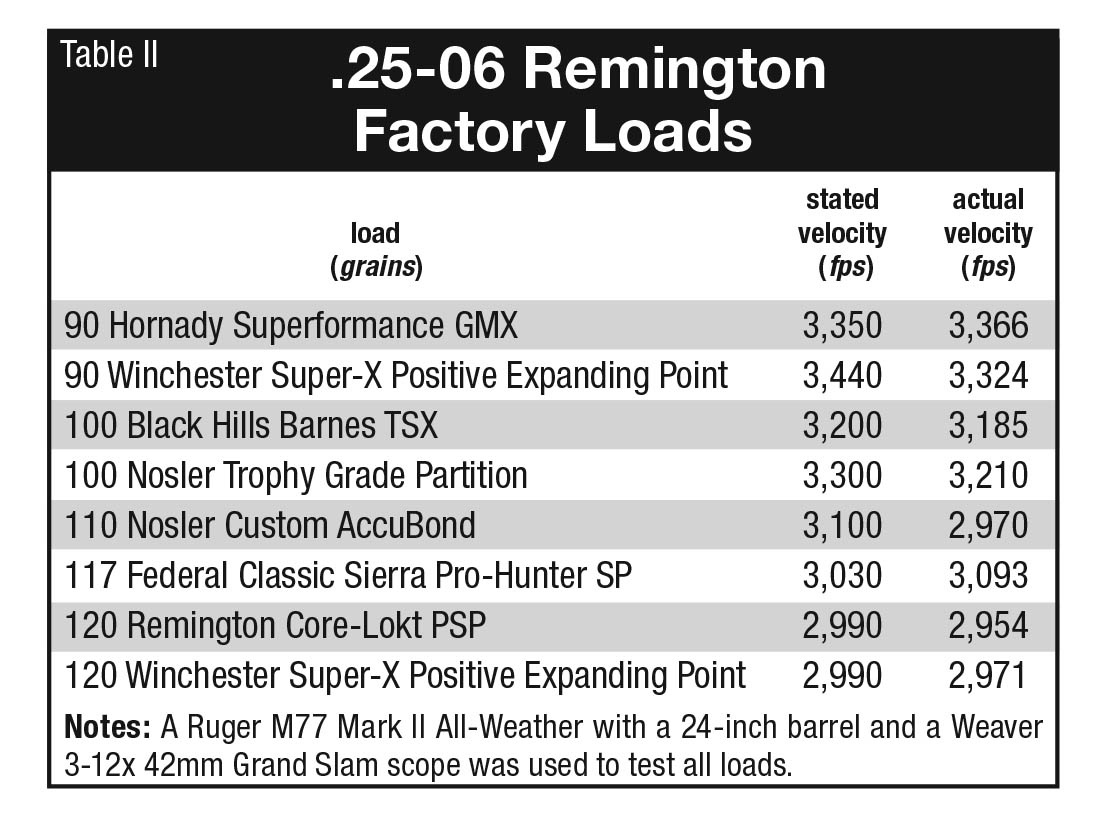
During subsequent firings and reloading of the cases, the sizing die was adjusted so that cases were sized just enough to permit reliable chambering in this particular rifle. This will usually increase accuracy and extend case life by working the case less. However, when assembling ammunition for hunting or use in more than one rifle, full-length sizing is suggested. RCBS dies were used to develop the accompanying handload data.
All cases were primed using CCI BR-2 Large Rifle primers, which serve to lower extreme velocity spreads and offer overall greater consistency. Federal GM210M primers can be interchanged with the accompanying data and will give essentially identical performance.
Bullet technology has significantly improved the terminal performance capabilities of the .25-06. For example, when hunting deer-size game, the selection is extensive. For those seeking deep penetration, the Hornady 90-grain GMX, Barnes 80- and 100-grain Triple-Shock X-Bullets, Nosler 100-, 115- and 120-grain Partitions and the 120-grain Swift A-Frame are excellent choices and, in the hands of a skilled hunter, will reliably take game larger than deer. Noteworthy general-purpose deer bullets include the Hornady 110-grain InterBond and 117-grain SST, Nosler 100- and 115-grain Ballistic Tip and the Swift 100-grain Scirocco II. Perhaps the most versatile general-purpose bullets include the Hornady 110-grain ELD-X and Nosler 110-grain AccuBond, which offer an excellent blend of controlled expansion along with a high ballistic coefficient to aid in long-range work, and they can be pushed to over 3,100 fps.

I regularly hunt Idaho coyotes and wolves. The coyotes are often taken at long range, and the wolves usually weigh 85 to 110 pounds but can occasionally reach up to 130 pounds. Heavier “varmint” bullets offer a higher BC that helps extend their effective range on coyotes and offers notable terminal per-
formance on large wolves. Last fall, my son assembled handloads containing Nosler 100-grain Ballistic Tip bullets for his left-hand Ruger M77 Hawkeye .25-06 for the above purposes, and they grouped under .5 inch. I watched as he took a coyote at long distance. Soon thereafter, he shot a mule deer broadside at 402 laser-measured yards, with the bullet penetrating both lungs and exiting the offside.
Handloaders should take note that bullets of a given weight are not necessarily interchangeable with data (including powder charges) that was developed for a different bullet of the same weight. Differences in design, material and bearing surface will change pressures. Likewise, changing bullet seating depth will have an effect on pressure. Monolithic expanding bullets such as the Hornady GMX and Barnes Triple-Shock X-Bullet generally produce the best accuracy when seated comparatively deep – usually at least .010 inch off of the lands. This deep seating also serves to reduce pressure. If the bullets listed are seated closer to the lands, pressures may increase.
Regarding bullet seating depth, I have checked the throat length of a number of rifles manufactured by several different companies and found notable differences. It will be beneficial to seat bullets to best correspond with your rifle for best accuracy. Typically, rifles with short throats will produce higher pressures when compared with a rifle that has a longer throat.
Traditional general-purpose powders for the .25-06 have included IMR-4350, IMR-4831, Hodgdon H-4350, H-4831 and Winchester 760, all of which still produce excellent results. However, there are many new powders worthy of consideration. For lightweight varmint bullets, Hodgdon Varget, Alliant Reloder 15, Reloder 19, IMR-4350, IMR-4320, IMR-4895 and Accurate 4350 provide low extreme spreads, excellent accuracy and often near top velocities.

If extruded powders are desired because they are known for producing top-notch accuracy, consider using short-cut versions to allow powder to drop through the .25-caliber case neck. This is beneficial when throwing charges from a powder measure, or when weighing each charge and pouring it into the case mouth with the aid of a funnel. For example, instead of using IMR-7828, use IMR-7828ssc. Similarly, try substituting H-4831 with H-4831sc. There are many other extruded powders that will drop through the neck without difficulty.
I was pleased with the accuracy and velocities produced by several of the spherical powders selected because they can be used to duplicate factory load velocities and pressure and provide smooth, uniform metering. These included Accurate 2700, Magpro, Winchester 760, Alliant Power Pro 4000-MR, Ramshot Magnum and Long Range Tactical (LRT). However, be certain to never reduce the suggested “start” loads, or erratic ignition and pressures can occur.
The .25-06 is an excellent cartridge that offers magnum performance, moderate recoil, respectable barrel life and accuracy. With a little creative experimenting, excellent handloads can be assembled that will increase the .25-06’s overall performance.


